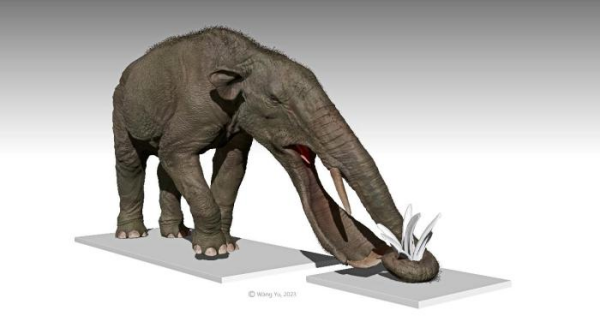Longer mandible or nose? Co-evolution of feeding organs in early elephantiforms
Elephants, as the largest terrestrial mammals, are renowned for their distinctive feature - the flexible and agile trunk. Described as the most sensitive organ among vertebrates, an elephant's trunk boasts at least 40,000 muscles and a highly developed nervous system. However, the extent to which the ancestors of elephants possessed a trunk is challenging to ascertain due to a lack of direct fossil evidence. Nevertheless, early scholars noted that during the early evolution of elephants, including the Oligocene and Miocene epochs, various elephant species exhibited significantly elongated lower jaws and lower incisors, particularly during the early to middle Miocene. How did these early elephant species utilize their diverse lower jaws and incisors for feeding, and what role did the trunk play in the feeding process?
In the latest research, scientists conducted a comprehensive study on the diversity and evolutionary history of the lower jaws in proboscideans, along with the coevolution of the trunk. The findings, published on the eLife journal in the November 29, 2023, shed light on the unique evolutionary processes related to the feeding strategies of early elephant species and the associated anatomical adaptations.
The study reveals that, during the Middle Miocene Climatic Optimum around 17-15 Ma years ago, the shovel-tusked elephant species, Platybelodon, had developed a feeding method where it used its trunk to coil around plants and its lower jaw to cut them. This provides early evidence of the trunk's gripping function in elephant feeding. The research compared the functional morphology of three major long-jawed elephant groups—Amebelodontidae, Gomphotheriidae, and Choerolophodontidae. These species exhibited distinct lower jaw morphologies: Platybelodon had shovel-like lower incisors, Gomphotherium had cylindrical lower incisors with enamel bands, and Choerolophodon lacked lower incisors but had elongated and grooved lower jaw joints.
To gain insights into the feeding habits and strategies of these early elephants, the research team employed various methods, including dental enamel stable isotope analysis and finite element mechanics. Stable isotope analysis provided evidence of different dietary preferences among the three elephant groups, while finite element mechanics helped reconstruct their feeding methods.
The results indicate that Platybelodon, Choerolophodon, and Gomphotherium exhibited distinct feeding behaviors and inhabited different environments. Platybelodon, living in more open environments, had a lower jaw suited for cutting vertically growing plants. It employed its flexible trunk to grasp plants and then used the lower jaw for horizontal cutting, resulting in highly efficient feeding. Choerolophodon, adapted to relatively closed environments, were suitable for cutting horizontally or diagonally growing branches. They used their trunks to press down branches, aided by the lower jaw during feeding. Gomphotherium, with an intermediate habitat preference, displayed diverse feeding methods, adapting well to both forested and grassland environments.
The study underscores that elongated lower jaws and lower incisors were the primary feeding organs for early elephants, with the trunk serving as an auxiliary tool. Different early elephant species with distinct lower jaw morphologies exhibited varied ecological adaptations. As the climate gradually became cooler and drier, Platybelodon, thriving in more open environments, played a crucial role in promoting the development of the trunk's grasping function and flexibility.
The expansion of Platybelodon into open environments was interrupted by the Tortonian hyperthermal event in the Late Miocene, leading to extinctions, including Platybelodon. However, Gomphotherium replaced Platybelodon, continuing to spread into open environments until the Late Miocene. During the evolutionary process, the feeding function of elephants transitioned entirely to the trunk, ultimately resulting in the unexpected and simultaneous shortening of the once elongated lower jaws and lower incisors. Thus, the adaptability of feeding behavior in open environments acted as a catalyst for the evolution of the trunk's gripping function. This research provides crucial evidence for understanding the coevolution of the trunk and lower jaw in proboscideans, offering new insights into how elephants adapted to their environment and how environmental changes shaped the evolution of their unique organs.
The paper's first author is Dr. Chunxiao Li, a postdoctoral researcher at the University of the Chinese Academy of Sciences. The corresponding authors are Dr. Shiqi Wang and Dr. Tao Deng from the Institute of Vertebrate Paleontology and Paleoanthropology, Chinese Academy of Sciences, and Dr. Ji Zhang from Huazhong University of Science and Technology. The work was supported by the National Natural Science Foundation of China and the Second Tibetan Plateau Scientific Expedition.
Link: https://doi.org/10.7554/eLife.90908.1

Figure 1. Morphology of the narial region and mandible of three gomphothere families compared with an extant elephant, and the elephantiformes phylogeny.

Figure 2. Finite element analyses of feeding behaviors among three longirostrine gomphothere families and reconstruction of their feeding ecology.

Figure 3. 3D restoration model of the Platybelodon.
Download attachments: